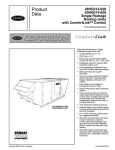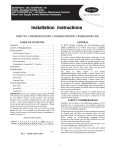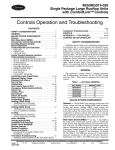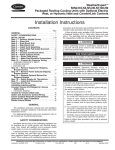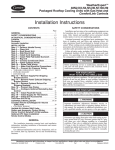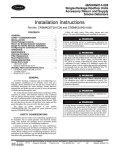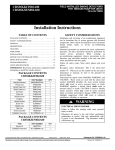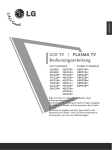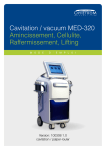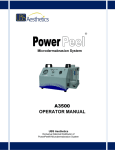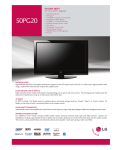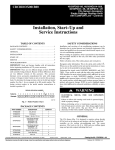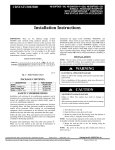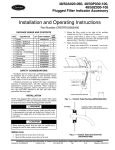Download Carrier 48/50HG014-028 Specifications
Transcript
48/50HG014-028 48/50PG20-28 Large Rooftop Units with COMFORTLINK™ Controls Economizer Package Accessory Installation Instructions Part Number CRECOMZR009E00 and CRECOMZR011E00 CONTENTS GENERAL . . . . . . . . . . . . . . . . . . . . . . . . . . . . . . . . . . . . . . . . 1 PACKAGE USAGE AND CONTENTS . . . . . . . . . . . . . . 1 SAFETY CONSIDERATIONS . . . . . . . . . . . . . . . . . . . . . . 2 INSTALLATION . . . . . . . . . . . . . . . . . . . . . . . . . . . . . . . . . 2-6 CONFIGURATION . . . . . . . . . . . . . . . . . . . . . . . . . . . . . . 7-9 TROUBLESHOOTING. . . . . . . . . . . . . . . . . . . . . . . . . . . . 10 IMPORTANT: There are two different design revision 48/50HG units currently being produced. Because of these differences, there are two different versions of this accessory. This accessory literature covers accessories manufactured for units with design revision 1. Design revision 0 units are not covered in this accessory book. To determine the design revision, refer to the full unit model number. See Fig. 1 for an example of an HG model number. The design revision number in the model number nomenclature is located in position 13. DESIGN REVISION NUMBER Position No. Example: 9 10 11 12 13 14 15 16 4 8 H G D 0 1 6 A 1 2 3 4 5 6 7 8 A C 6 1 1 A A Fig. 1 — Model Number Chart GENERAL IMPORTANT: Read these instructions completely before attempting to install the accessory economizer. The accessory economizer package uses microprocessorbased controls to sequence mechanical cooling with cool outdoor air (free cooling) to satisfy the cooling load and minimize energy consumption. Free cooling can be used alone or in conjunction with mechanical cooling. The standard economizer uses an outdoor-air temperature sensor to sense outdoor-air temperature. When the outdoor-air temperature is between two configurable ambient temperatures, the economizer is allowed to cool. These temperature configurations are the Economizer High Temperature Lockout (ECL.H) and the Economizer Low Temperature Lockout (ECL.L). The economizer will provide cooling when the outdoor temperature is suitable as defined above by the lockout settings and if there is a cooling demand. In addition, if an outdoor enthalpy sensor accessory has been installed, then the enthalpy reading must also be “low” before economizer cooling can occur. When free cooling is available, the economizer sequences free cooling with up to three stages of mechanical cooling to maintain comfort in the space. When free cooling is not available, the economizer modulates to an adjustable minimum position to maintain a supply of fresh air entering the building. Optional barometric relief dampers provide natural building pressurization control. An optional power exhaust system is available for jobs requiring greater relief. PACKAGE USAGE AND CONTENTS UNIT SIZE PART NO. QTY CONTENTS 50TG500495 1 Damper Assy 50TG403161 1 Blockoff 50TG500303 1 Lower Hood Top Panel 50TG500301 1 Hood Side 50TG500302 1 Hood Side 50TG501090 2 Side Filter Guide 50TG500304 1 Upper Hood Top Panel 50TG500306 1 Filter Bracket 50TG501091 1 Filter Retainer Track 48/50PG20-24, KH03DU350 3 Filter 48/50HG014-024 (CRECOMZR009E00) 50ZZ401127 1 Control Board AL56AU130 5 No. 6 Screw AL48AM307 10 1/4-in. Screw x 5/8-in. AL31AZ308 25 1/4-in. Screw x 3/4-in. AS41BZ133 3 Speed Nut HY76TB110 5 Wire Tie HY76TB125 1 Wire Tie 50TG402594 1 Harness Assy — 1 Seal Strip 50TG500496 1 Damper Assy 50TG403163 1 Blockoff 50TG500303 1 Lower Hood Top Panel 50TG500301 1 Hood Side 50TG500302 1 Hood Side 50TG501090 2 Side Filter Guide 50TG500304 1 Upper Hood Top Panel 50TG500306 1 Filter Bracket 50TG501091 1 Filter Retainer Track 48/50PG28, KH03DU350 3 Filter 48/50HG028 (CRECOMZR011E00) 50ZZ401127 1 Control Board AL56AU130 5 No. 6 Screw AL48AM307 10 1/4-in. Screw x 5/8-in. AL31AZ308 22 1/4-in. Screw x 3/4-in. AS41BZ133 3 Speed Nut HY76TB110 5 Wire Tie HY76TB125 1 Wire Tie 50TG402594 1 Harness Assy — 1 Seal Strip NOTE: If unit is already equipped with an outdoor air hood, hood parts in the accessory will not be used and may be discarded. Manufacturer reserves the right to discontinue, or change at any time, specifications or designs without notice and without incurring obligations. PC 111 Catalog No. 534-80235 Printed in U.S.A. Form 48/50H,P-18SI Pg 1 6-05 Replaces: New Book 1 1 4 4 Tab 1a 1b 6a 6b SAFETY CONSIDERATIONS Installation and servicing of air-conditioning equipment can be hazardous due to system pressure and electrical components. Only trained and qualified service personnel should install, repair, or service air-conditioning equipment. Untrained personnel can perform basic maintenance functions of cleaning coils and filters and replacing filters. All other operations should be performed by trained service personnel. When working on air-conditioning equipment, observe precautions in the literature, tags and labels attached to the unit, and other safety precautions that may apply. Follow all safety codes. Wear safety glasses and work gloves. Use quenching cloth for unbrazing operations. Have fire extinguishers available for all brazing operations OUTDOOR AIR HOOD IMPORTANT: Do not adjust the damper assembly. The motor and damper have been pre-set and adjusted for proper operation. Fig. 2 — Outdoor Air Hood INSTALLATION Turn off unit power and lock out. Electrical shock and personal injury could result. 1. Prepare the unit for installation: a. For units with two-position damper installed remove the outdoor air hood. See Fig. 2. Unplug the two-position damper and remove the assembly from the outdoor air opening. b. For units with manual damper installed, remove the outdoor air hood and damper assembly. c. For units with no outdoor air option installed, remove the outdoor air intake cover. See Fig. 3. 2. Remove the side panel on the return end of the unit to expose the return section of the unit. Save the screws for use later when replacing the panel. The inside of the unit will contain a frame for installing the economizer as shown in Fig. 4. OUTDOOR AIR INTAKE COVER Fig. 3 — Outdoor Air Intake Cover Cover the duct opening as a precaution so objects cannot fall into the return duct opening. Be sure to remove the cover when installation is complete. 3. Remove the frame support brackets from both sides of the frame inside the unit. See Fig. 4. Save the screws for use later. 4. Uncrate the economizer assembly. Position the damper assembly so that it will rest on the angle bracket support at the bottom of the economizer frame inside the unit. Slide the economizer into the unit. (See Fig. 5.) Secure the damper assembly to the frame using the 1/4-in. x 5/ -in. screws provided. 8 5. Open the hinged control box compartment on the unit and remove the control box cover. Save the screws for use later. Be sure not to place sharp objects on any surface that could be damaged. 6. Install the economizer board (P/N 50ZZ401127) into the control box using the no. 6, 3/4-in. screws provided. The economizer board will mount into the pre-drilled holes on the right side flange of the control box as shown in Fig. 6. FRAME SUPPORT BRACKETS (SIDE PANEL REMOVED) Fig. 4 — Frame Support Brackets (Side Panel Removed) 2 11. Connect the motor plug to the plug provided with the harness. (See Fig. 9.) 12. Install the insulated partition (block-off panel) by sliding the panel into the unit from the side. The damper side of the panel will slide along the top of the flange of the damper assembly, between the return and outdoor air damper blades. The panel should then be rotated upwards so that the mounting holes align with the holes in the panels at the end of the unit. Once in the correct position, the partition will be horizontal inside the unit as shown in Fig. 10. 13. Secure the partition to the frame using the screws saved from Step 3, at the edges of the partition as shown in Fig. 11. 14. The installation of the damper assembly is now complete. Units with Outdoor Air Hood: If the unit was equipped with an outdoor air hood, replace the outer unit panels using the screws saved from the earlier steps. Be sure to inspect all panel seals prior to re-assembly and replace any seals that appear damaged. Units without Outdoor Air Hood: If the unit was not equipped with an outdoor air hood, perform the following procedure to install the hood: a. Make sure power supply is off. b. Apply seal strip provided to back flange of both hood sides where the hood side connects to the unit back panel. See Fig. 12. c. Apply seal strip provided to top flange of both hood sides where hood sides connect to the hood top panels. See Fig. 12. d. Install hood sides to the back panels using the screws provided. The sloped flanges point outward. The drip edges of the side panels should face outward as well. The filter guides attach to the hood sides. The flanges should face inward to hold the filters in place. See Fig. 12. e. Apply seal strip along the entire length of the bottom flange of the hood top. See Fig. 12. f. Install the bottom part of the hood top using 4 screws provided. See Fig. 12. Fig. 5 — Slide Economizer Assembly into Unit 7. Connect the wiring harness (P/N 50TG402594) into the Economizer Control Board (ECB) plugs J1 and J2 and to the Main Base Board plugs J2 and J3. See Fig. 7 and 8. Be sure to connect the plugs with the proper orientation such that the locking tabs capture the plug. 8. Connect the air quality plug marked “TB2-J10” from the wiring harness into the TB-J10 plug on the main base board. Be sure to connect the plug with the proper orientation such that the locking tabs capture the plug. 9. Pass the harness wires through the hole in the control box and into the return air section. Be sure to secure the wires so that they will not interfere with any moving parts. 10. Route the wire harness across the frame support as shown in Fig 9. The motor plug (PL7) should be located at the actuator side of the unit and snaps into the frame support bracket. Be careful not to damage the wires. Route the harness across the back of the top member of the frame as shown and attach to the frame using the wire ties provided. ComfortLink ECONOMIZER CONTROL BOARD LOCATION TB2-J10 Fig. 6 — Unit Control Box 3 g. Install the top part of the hood top using the 6 screws removed in Step 2. See Fig. 12. h. Install the filter retainer track along the bottom edge of the outdoor air hood using 4 screws provided. For filter removal, remove the four screws holding the filter retainer. The filters can then be removed, cleaned, or replaced. RELAYS IMPORTANT: If the return duct opening was covered prior to installation, remember to remove the covering so as not to block off the return air to the unit. ECB-J7 ECB-J9 15. Secure all wires so that they do not rub any sharp edges or interfere with any moving parts. 16. Replace the control box cover using the screws saved from Step 5. Economizer wiring is shown in Fig. 13. 17. Power can now safely be restored to the unit. 18. Install the three mist eliminating filters supplied into the outdoor air inlet hood. 19. Inspect the unit to make sure all panels are properly replaced and secured to the unit. 20. Configure the unit for use with economizer. RED LED-STATUS MAIN BASE BOARD PART NUMBER ECONOMIZER CONTROL BOARD DIP SWITCHES (S1) ECB-J2 ECB-J5 ECB-J4 Fig. 7 — Economizer Control Board GREEN LEDLEN (LOCAL EQUIPTMENT NETWORK) YELLOW LED CCN (CARRIER COMFORT NETWORK) INSTANCE JUMPER CEPL130346-01 J1 J4 STATUS J2 J10 LEN J3 CCN J5 J6 J7 J8 Fig. 8 — Main Base Board 4 J9 WIRE HARNESS PLUG PL7 Fig. 9 — Wire Harness Routing INSULATED BLOCK-OFF PANEL MOUNTING HOLES MOUNTING HOLES Fig. 10 — Economizer Block-Off Panel Location Fig. 11 — Secure Block-Off Panel to Frame 5 TOP HOOD SECTION SEAL STRIP LOCATION HOOD SIDE ADD SEAL STRIP ADD SEAL STRIP INNER FILTER TRACK ADD SEAL STRIP BOTTOM HOOD SECTION ADD SEAL STRIP FILTER GUIDE FILTER RETAINER FILTER GUIDE FILTER HOOD SIDE UNIT BACK PANEL Fig. 12 — Outdoor Air Hood Details Fig. 13 — Economizer Wiring 6 CONFIGURATION 5. Use the arrow keys to change the configuration from “NO” to “YES”, then press ENTER and ESCAPE to save the setting. 6. If additional economizer control accessories have been added or other configuration parameters are to be changed from the factory defaults, then repeat the following steps: a. Use the arrow keys to scroll up or down to the parameter to change. Press ENTER once to select the setting for configuration. b. Press ENTER again. The configuration value will flash. c. Use the arrow keys to change the configuration value. d. Press ENTER and ESCAPE to save the setting. 7. Configuration of the ComfortLink control is now complete. Pressing ESCAPE multiple times will return the display to the auto-scrolling setting. 8. Close and secure all access doors. NOTE: The economizer static pressure drop must be accounted for after installation. See Table 5. Refer to the Controls and Troubleshooting literature for information on adjusting the fans. The ComfortLink™ control must be configured for economizer operation. The default values are for no economizer and no IAQ accessories installed. These configurations are changed through the Scrolling Marquee display or a Carrier network device. The configuration parameters and factory default values for economizer configuration and indoor air quality configuration are shown in Tables 1-4. NOTE: Consult the Controls, Start-Up, Operation, Service and Troubleshooting Instructions for in-depth instructions on using and configuring the ComfortLink control. The following instructions are for the Scrolling Marquee display or Navigator™ accessory. 1. The ComfortLink control must be configured to use the economizer accessory. A password may be required to edit the configurations depending on previous settings configured in the unit. Default password is “1111”. 2. To configure the ComfortLink control, use the arrow keys to scroll the red LED on the display to the “Configuration” position and press ENTER. 3. Use the arrow keys to scroll down until the display shows “ECON”. This is the Economizer Configuration sub mode. Press ENTER. 4. The control will display the Economizer Installed (EC.EN) setting. Press ENTER once to select the EC.EN setting for configuration. Press ENTER again for “NO” to begin flashing. Table 1 — Economizer Configuration Table (48/50PG Units) ITEM EXPANSION ECON →EC.EN Economizer Configuration Economizer Installed →E.CTL Economizer Control Type →EC.MN →EC MX →H.4M →H.20M →EH.LO →EL.LO →UEFC Econo Minimum Position Econo Maximum Position RH Sensor Value at 4mA RH Sensor Value at 20mA Econo Hi Temp Limit Econo Lo Temp Limit Unoccupied Free Cooling →FC.TM →FC.LO →PE.EN Free Cool PreOcc Time Free Cool Low Temp Limit Power Exhaust Installed →PE.1 →PE.2 →EN.SW PE Stage1 Econo Position PE Stage2 Econo Position Enthalpy Switch →E.TRV →E.MXB →E.MXM →E.MXT →E.DBD →EC.P →EC.I →EC.D →EC.DT Economizer Travel Time Bottom Stage Max Econo Middle Stage Max Econo Top Stage Max Econo Economizer PID Deadband Economizer PID — kP Economizer PID — kI Economizer PID — kD Economizer PID — rate RANGE UNITS CCN TABLE/ SUB-TABLE ECON_CFG CCN POINT DEFAULT Yes/No ECONO 1=Digital, Position Feedback 2=Digital, Command Feedback 3=Analog Control 0 to 100 0 to 100 0 to 50 60 to 100 40 to 100 –30 to 50 0=Disabled 1=Entire Unoccupied Period 2=PreOccupancy Time 1 to 9999 0 to 70 Yes/No ECON_CTL No: no FIOP Yes: FIOP 1 % % % % dF dF ECONOMIN ECONOMAX RH_4MA RH_20MA OATLECLH OATLECLL UEFC_CFG 30 100 0 100 65 0 2 min dF UEFCTIME OATLUEFC PE_ENABL % % PE1_POS PE2_POS ENTHLCFG 120 50 No: no FIOP Yes: FIOP 40 75 0: no FIOP 1: FIOP sec % % % % sec sec sec sec ECONOTRV ECONMAXB ECONMAXM ECONMAXT ECONBAND ECONO_P ECONO_I ECONO_D ECONO_DT 10 to 100 10 to 100 0=No Switch 1=Normally Open 2=Normally Closed 5 to 300 0 to 100 1 to 100 0 to 100 0 to 25 0.0 to 99.9 0.0 to 99.9 0.0 to 99.9 10.0 to 180.0 LEGEND FIOP — Factory-Installed Option 7 150 50 35 0 3 2.5 0.1 1 15 Table 2 — Air Quality Configuration Table (48/50PG Units) ITEM EXPANSION RANGE AIR.Q →IA.CF Air Quality Configuration IAQ Analog Input Config →IA.FN IAQ Analog Fan Config →II.CF IAQ Switch Input Config →II.FN IAQ Switch Fan Config →AQ.MN →EC.MN →OVR.P →OA.CF Econo Min IAQ Position Econo Minimum Position IAQ Override Position OAQ Analog Input Cfg →OAQ.L →AQD.L →AQD.H →DF.ON →DF.OF →I.4M →I.20M →O.4M →O.20M OAQ Lockout Limit AQ Differential Low AQ Differential High Fan On AQ Differential Fan Off AQ Differential IAQ Sensor Value at 4mA IAQ Sensor Value at 20mA OAQ Sensor Value at 4mA OAQ Sensor Value at 20mA UNITS CCN TABLE/ SUB-TABLE IAQ_CFG 0=No IAQ 1=Demand Ventilation 2=Econ Position Override 3=Econ Min Position Control 0=Never 1=Only While Occupied 2=Always 0=No IAQ 1=DCV Normally Open 2=DCV Normally Closed 3=Override Normally Open 4=Override Normally Closed 0=Never 1=Only While Occupied 2=Always 0 to 100 0 to 100 0 to 100 0=No OAQ 1=Demand Ventilation 2=Outdoor Air Lockout 0 to 5000 0 to 5000 0 to 5000 0 to 5000 0 to 5000 0 to 5000 0 to 5000 0 to 5000 0 to 5000 CCN POINT DEFAULT IAQANCFG 0: no FIOP 1: FIOP IAQANFAN 0 IAQINCFG 0 IAQINFAN 0 IAQMINP ECONOMIN IAQOVPOS OAQANCFG 10 30 100 0 OAQLOCK DAQ_LOW DAQ_HIGH DAQFNON DAQFNOFF IAQ_4MA IAQ_20MA OAQ_4MA OAQ_20MA 600 100 700 600 200 0 2000 0 2000 LEGEND FIOP — Factory-Installed Option Table 3 — Economizer Configuration Table (48/50HG Units) SUBMODE ITEM DISPLAY ECON ITEM EXPANSION COMMENT Economizer Configuration EC.EQ YES/NO Economizer Equipped Unit E.CTL X Economizer Control Type Default: 3 1 = Digital/Position 2 = Digital/Command 3 = Analog Control MIN.P XXX Economizer Min Position Default: 30 % ECL.H XX Econ High Temp Lockout Default: 65 F ECL.L XX Econ Low Temp Lockout Default: 0° F Default: 2 0 = Disabled 1 = Unoccupied 2 = Preoccupancy UEFC X Unoccupied Free Cooling FC.TM XXX Free Cooling Preoccupancy Time FC.LL XX Free Cooling Low Temperature Limit Default: NO Default: 120 sec Default: 50 F Default: 0 0: No Switch 1: Normal Open 2: Normal Close Default: DSBL (ENBL if equipped with power exhaust) EN.SW X Enthalpy Switch Input PE.EN ENBL/DSBL Power Exhaust Control PE1.P XXX PE Stage1 Econo Position Default: 40 % PE2.P XXX PE Stage2 Econo Position Default: 75 % 8 Table 4 — Indoor Air Quality Configuration Table (48/50HG Units) SUBMODE ITEM DISPLAY ITEM EXPANSION IAQ COMMENT IAQ Configuration Default: 0 if no IAQ sensor installed 1 if IAQ sensor installed 0 = No IAQ 1 = Demand Control Ventilation (DCV) 2 = Override IAQ 3 = Control Minimum Position Default: 0 0 = Never 1 = Occupied 2 = Always Default: 0 0 = Not Switch 1 = DCV NO 2 = DCV NC 3 = Override NO 4 = Override NC Default: 0 0 = Never 1 = Only When Occupied 2 = Always IA.CF X IAQ Input Configuration IA.FN X Fan Enable for IAQ Input II.CF X IAQ Level (Switch Input) II.FN X IAQ Switch Input Fan CFG AQ.MP XXX Minimum IAQ Position Default: 10 % MIN.P XXX Economizer Min Position Default: 30 % OVR.P XXX Econo Override Position Default: 100% OA.CF X OAQ Sensor Operation Default: 0 0 = No OAQ 1 = DCV OAQ 2 = Lockout OAQ OAQ.L XXXX OAQ Lockout Valve Default: 600 ppm AQD.L XXX AQ Differential Low Default: 100 ppm AQD.H XXXX AQ Differential High Default: 700 ppm DF.ON XXX Fan On AQ Differential Default: 600 ppm DF.OF XXX Fan Off AQ Differential Default: 200 ppm I.4M XXXX IAQ Sensor Value at 4MA Default: 0 ppm I.20M XXXX IAQ Sensor Value at 20MA Default: 2000 ppm O.4M XXXX OAQ Sensor Value at 4MA Default: 0 ppm O.20M XXXX OAQ Sensor Value at 20MA Default: 2000 ppm H.4M XXX RH Sensor Value at 4 mA Default: 0% Range: 0-100% H.20M XXX RH Sensor Value at 20 mA Default: 100% Range: 0-100% RH.SP XX Space RH Setpoint Default: 50% Range: 30-95% RH.DB XX Space RH SetPnt Deadband Default: 5% Range: 2-20% Table 5 — Accessory Economizer Static Pressure (in. wg)* — 48/50HG020-028 and 48/50PG20-28 Units COMPONENT Economizer COMPONENT Economizer 4,000 0.02 4,500 0.03 5,000 0.04 8,500 0.11 9,000 0.12 9,500 0.13 5,500 0.05 10,000 0.15 *The static pressure must be added to the external static pressure. The sum and the evaporator entering-air cfm should then be used in conjunction with the Fan Performance tables to determine blower rpm and watts. 9 CFM 6,000 0.06 CFM 10,500 0.16 6,500 0.07 7,000 0.08 11,000 0.17 7,500 0.09 11,500 0.19 8,000 0.10 12,000 0.20 TROUBLESHOOTING and Possible Causes, Economizer Troubleshooting, and Economizer Adjustment. See Table 6 for general economizer service analysis. Refer to the Controls, Start-Up, Operation, Service and Troubleshooting Instructions for more information on the following topics: Service Test, Diagnostic Alarm Codes Table 6 — Economizer Service Analysis PROBLEM Damper Does Not Move. POSSIBLE CAUSE Indoor Fan is off. Actuator is unplugged at motor or at economizer board. Unit is not configured for economizer. Outdoor air temperature is above economizer high temperature lockout. Outdoor air temperature is below economizer low temperature lockout. Economizer Operation is Limited to Minimum Position. Communication loss to economizer board. Damper is jammed. Minimum position is set incorrectly. Outdoor-air temperature is above economizer high temperature lockout. Outdoor-air temperature is below economizer low temperature lockout. Outdoor-air thermistor is faulty. Low suction pressure problem with a compressor. Economizer Position is Less than Minimum Position. IAQ is controlling minimum damper position. Unit is in Unoccupied mode. Economizer Does Not Return to Minimum Position. Outdoor Damper Not Fully Closed at 0% Commanded Position or Not Fully Open at 100%. Damper Does Not Close on Power Loss. Unit is operating under free cooling. Economizer actuator is out of calibration. Damper is jammed. LEGEND CCN — Carrier Comfort Network IAQ — Indoor Air Quality 10 REMEDY Check proper thermostat connection. Unit is not configured for continuous fan operation and the thermostat is not calling for heating or cooling. Unit is in Unoccupied mode and there is no call for heating or cooling. Blown fuse (FU1, FU2). Tripped circuit breaker (CB1, CB2, CB3). No power to the unit. Unit is off via CCN command. Check wiring connections. Configure unit for economizer per the instructions. Adjust the high temperature lockout setting if it is incorrect, otherwise, economizer is operating correctly. Adjust the low temperature lockout setting if it is incorrect, otherwise, economizer is operating correctly. Check wiring connections. Identify the obstruction and safely remove. Adjust minimum position setting. Adjust the high temperature lockout setting if it is incorrect, otherwise, economizer is operating correctly. Adjust the low temperature lockout setting if it is incorrect, otherwise, economizer is operating correctly. Replace outdoor air thermistor. Economizer is operating correctly, identify compressor problem. Adjust the IAQ settings if incorrect, otherwise the economizer is operating correctly. Adjust unit occupied schedule if incorrect, otherwise, economizer is operating correctly. Economizer is operating correctly. Enter Service Test mode and run the Calibrate Economizer (Service Test→INDP→E.CAL) procedure. Identify the obstruction and safely remove. 9. 10. 11. 12. 13. 14. Copyright 2005 Carrier Corporation Manufacturer reserves the right to discontinue, or change at any time, specifications or designs without notice and without incurring obligations. PC 111 Catalog No. 534-80235 Printed in U.S.A. Form 48/50H,P-18SI Pg 12 6-05 Replaces: New Book 1 1 4 4 Tab 1a 1b 6a 6b













